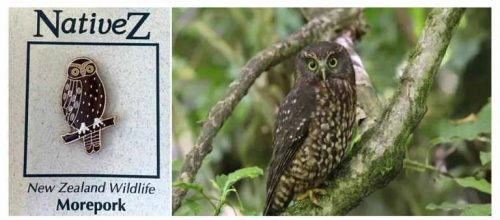Speaking of New Zealand, the most popular is the climate, environment, and natural vegetation of New Zealand. Of course, the corruption-free corruption that other countries long for. The global corruption index, released by transparency international, an NGO that monitors corruption around the world, ranks New Zealand first and least corrupt among 176 countries and regions.
Unique island countries and temperate marine climate breed the most exotic birds in nature. Look at the custom pins of the countries from bird paradise.
No.1 Morepork
Morepork’s mouth is firm and slightly hook up. It preys on large insects, lizards, and voles on the ground or tree branches at night, and some species also eat plant fruits. The Morepork sleep in the branches in the daytime and only comes out at night to hunt.

No.2 Stitchbird
Stitchbird is a Vulnerable species. The special birds that live in Australia and New Zealand can stitch the leaves into nests for habitation.
Meliphagoidea used to be an independent family with 276 species, forming the largest group of birds in Australia.
The family Melornithidae has long central tail feathers that inhabit forests and feed on insects, berries and nectar. There are two other species of Nectar birds in southern Africa, a total of 38 genera and 170 species. Nectar birds are the most common species of birds in Australia. Some species, such as Noisy Miner, are common birds in large cities in eastern Australia.

No.3 New Zealand Pigeon
The New Zealand Pigeon is a beautiful bird with metallic green, gold, and brown plumage and white feathers on its chest. And the tall figure is very conspicuous.
The New Zealand Pigeon was once widespread in New Zealand. Hunters hunted wooden pigeons for meat and beautiful bird feathers, but now they have become protected animals. Any killing is illegal.

No.4 Fantail
Also known as fan-tail flycatcher. Native to forests, banks, and beaches from South Asia to New Zealand. Native to South Asia to New Zealand, the forests are open, river Banks and beaches, and several species have become domesticated garden birds. There are more than 20 varieties, body-color gray, black, brown, or brown alternate with; There are usually significant white areas, especially on the abdomen, eyebrow, and tail.

No.5 Bellbird
It is a large parrot on the South Island of New Zealand. Living in rare Sparse wood shrub, large in size, rich in feathers, mainly green, beak thick and long. It mainly eats insects, crabs, carrion meat. But they also attacked the sheep and even jumped on their backs. Their strong beaks could Pierce the skin and flesh of the sheep, swallow the fat on the sheep, and peck at the meat, leaving the live sheep bleeding.
The species declined in competition in food and living space. Although it is difficult to estimate the exact size of the population, it still suggests that the population may be small. For these reasons, the Bellbird listed as a vulnerable species.

No.6 Takahe
Takahe, a rare, flightless bird native to New Zealand, was thought to be extinct in the early 19th century but was found in a river valley on New Zealand’s south island in 1948.
The Takahe ‘s feeding habit is unique. They use their beaks to pluck the grass leaves, then grab the top end of the leaves with one paw, then feed on the most tender part of the bottom of the leaves and discard the rest. There are only 200 of them left.

No.7 Tuatara
This is the only one of these lapel pins that isn’t a bird.
The New Zealand Tuatara, which appeared on earth more than 200 million years ago, is one of the few ancient reptile species alive today.
The Tuatara are egg-laying animals whose sex is determined by the incubation temperature. When incubated at an ambient temperature of 22.25 ℃, all males hatch. Only when the ambient temperature is below 22.1℃ can hatch female lizards.
After simulating the effects of global climate change on the habitat of New Zealand’s great lizards, scientists concluded that it would be impossible for any more females to hatch after 2085. New Zealand’s great lizards will die out due to a shortage of females.

Now many rare animals are gradually disappearing. As a bird protector, we should always publicize the awareness of bird protection. It’s time to hand out these custom pins for publicity, which can also be very effective. I think most people will keep it as a collection, too. If you need to make more lapel pins of other precious animals, GS-JJ is a good enamel pin manufacturer.
